Rivera Sun's Blog: From the Desk of Rivera Sun, page 27
June 27, 2016
Got Strategy? Check Out Constructive Program
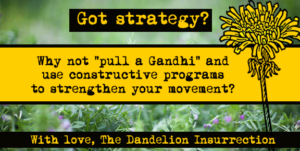 Many of us know about protests and marches, there is also a whole other side to nonviolence: constructive program.
Many of us know about protests and marches, there is also a whole other side to nonviolence: constructive program.
The phrase was coined by Gandhi whose famous salt and spinning campaigns combined both direct action and constructive program into powerful forces for change. A constructive program is more than a positive project; it should have political and social significance. It increases the self-reliance of the movement and lessens the dependency on the opposition. A constructive program is comprised of tangible actions that anyone can do (such as making salt or spinning cotton). Constructive program balances noncooperation with the destructive, with cooperation with the life-affirming or beneficial. Even if a constructive program is not directly confrontational to the injustice the movement faces, it should have revolutionary potential – if it succeeds, it should have the capacity to unravel the entire knot of the problem the movement faces.
Here’s a couple other examples of movements that used constructive program: the Civil Rights Movement (especially in the construction of Freedom Schools during the Mississippi Freedom Summer), and the United Farm Workers when they established their Credit Union.
Think for a moment. How might your movement use constructive program?
____________
In the Dandelion Insurrection novel, the characters used local food and urban gardening, creating an Alternet, the Suburban Renaissance’s tool coops and child care programs, and the training retreats of the “Dandelion Farms” to increase the self-reliance and resilience of the movement.
What is The Dandelion Insurrection? It’s a novel about a nonviolent movement for change in “a time that looms around the corner of today”, set in a (slightly) fictionalized United States to oust a not-so-hidden corporate dictatorship. Read the book, live the story.
You can find the book here: https://www.amazon.com/Dandelion-Insurrection-love-revolution/dp/098481325X
Not a fan of mega-corporations? You can also get a copy here: http://www.riverasun.com/online-store/the-dandelion-insurrection/
_____________________
A uthor/Activist Rivera Sun, syndicated by PeaceVoice, is the author of The Dandelion Insurrection, Billionaire Buddha and Steam Drills, Treadmills, and Shooting Stars, the cohost of Love (and Revolution) Radio, and the cofounder of the Love-In-Action Network. She is a trainer and social media coordinator for Campaign Nonviolence and Pace e Bene. Sun attended the James Lawson Institute on Strategic Nonviolent Resistance in 2014 and her essays on social justice movements appear in Truthout and Popular Resistance. www.riverasun.com
uthor/Activist Rivera Sun, syndicated by PeaceVoice, is the author of The Dandelion Insurrection, Billionaire Buddha and Steam Drills, Treadmills, and Shooting Stars, the cohost of Love (and Revolution) Radio, and the cofounder of the Love-In-Action Network. She is a trainer and social media coordinator for Campaign Nonviolence and Pace e Bene. Sun attended the James Lawson Institute on Strategic Nonviolent Resistance in 2014 and her essays on social justice movements appear in Truthout and Popular Resistance. www.riverasun.com
Got Strategy? Acts of Concentration and Dispersion
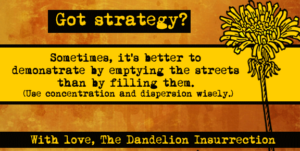 Acts of concentration are those that assemble human bodies in geographic areas together. Acts of dispersion are nonviolent actions that do not bring bodies into the same space. Why is this important? Because when violent repression is likely to occur, using acts of dispersion can keep people safe while still carrying out effective action.
Acts of concentration are those that assemble human bodies in geographic areas together. Acts of dispersion are nonviolent actions that do not bring bodies into the same space. Why is this important? Because when violent repression is likely to occur, using acts of dispersion can keep people safe while still carrying out effective action.
Think about the difference between filling the streets or emptying the streets. Both are forms of noncooperation and protest. Both might keep people from work, school, shopping, and regular activities. Both send a clear message to the opposition that the populace refuses to cooperate with them. But emptying the streets allows you to adjust for the likelihood of violence while still meeting those goals. If violence is unlikely, then yes, by all means, fill the streets. Just think carefully about which tactics you are using.
Acts of dispersion may include: boycotts, stay-at-homes, walk-outs, use of symbols, call-in-sicks, suspension of social affairs, rent withholding, lockout, severance of funds, refusing to pay fees, hartal (stopping work and regular affairs for a day of fasting and prayer), literature advocating resistance, hiding and escape, fasts, overloading systems and more.
Acts of concentration may include: strikes, picketing, rallies, demonstrations, marches, occupations, blockades, sit-ins, working-to-rule, slow-downs, vigils, pilgrimages, teach-ins, and many more.
Remember, there are some situations where concentration is more effective for a movement than dispersed acts. Acts of concentration can often be galvanizing, and are often very visible, which can help build support for a movement. Acts of intervention (which can require putting one’s physical body in harms way) tend to be highly disruptive to the opposition – which is why the threat of physical and violent repression increases!
Think through this aspect of your tactics as you strategize your campaign. Make wise choices, because this can become a life-or-death question. Using forethought around concentration or dispersion can contribute greatly to the long term success of your movement.
____________________
“An idea shot through the movement like a bird in flight: disperse, but move forward. The people vanished. All that remained was a rumble, an unease, a sense of a tidal wave approaching.” – The Dandelion Insurrection
What is The Dandelion Insurrection? It’s a novel about a nonviolent movement for change in “a time that looms around the corner of today”, set in a (slightly) fictionalized United States to oust a not-so-hidden corporate dictatorship. Whether or not it’s real . . . well, that all depends on you. Read the book, live the story.
You can find the book here:https://www.amazon.com/Dandelion-Insurrection-love-revolution/dp/098481325X
Not a fan of mega-corporations? You can also get a copy here: http://www.riverasun.com/online-store/the-dandelion-insurrection/
_____________________
A uthor/Activist Rivera Sun, syndicated by PeaceVoice, is the author of The Dandelion Insurrection, Billionaire Buddha and Steam Drills, Treadmills, and Shooting Stars, the cohost of Love (and Revolution) Radio, and the cofounder of the Love-In-Action Network. She is a trainer and social media coordinator for Campaign Nonviolence and Pace e Bene. Sun attended the James Lawson Institute on Strategic Nonviolent Resistance in 2014 and her essays on social justice movements appear in Truthout and Popular Resistance. www.riverasun.com
uthor/Activist Rivera Sun, syndicated by PeaceVoice, is the author of The Dandelion Insurrection, Billionaire Buddha and Steam Drills, Treadmills, and Shooting Stars, the cohost of Love (and Revolution) Radio, and the cofounder of the Love-In-Action Network. She is a trainer and social media coordinator for Campaign Nonviolence and Pace e Bene. Sun attended the James Lawson Institute on Strategic Nonviolent Resistance in 2014 and her essays on social justice movements appear in Truthout and Popular Resistance. www.riverasun.com
Civil Disobedience Is More Than Just “Getting Arrested”
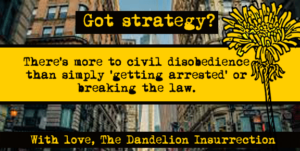 Civil disobedience is an art … and there’s more to it than simply “getting arrested.” The term comes from an essay by Henry David Thoreau, whose classic, “On Civil Disobedience” was written in relation to slavery and the Mexican-American war. Thoreau felt it was the duty of citizens to resist through noncooperation and disobedience the machine of a system or government that produces injustice.
Civil disobedience is an art … and there’s more to it than simply “getting arrested.” The term comes from an essay by Henry David Thoreau, whose classic, “On Civil Disobedience” was written in relation to slavery and the Mexican-American war. Thoreau felt it was the duty of citizens to resist through noncooperation and disobedience the machine of a system or government that produces injustice.
More specifically, civil disobedience has been used in relation to deliberately disobeying laws that are perceived as unjust. Gandhi upped the ante on the concept, organizing mass civil disobedience to specific British laws, whereby making them completely unenforceable. In this way, Gandhi not only achieved the repeal of many laws, but also undermined the authority and control of the British colonial government.
Sometimes, civil disobedience is practiced in the United States in a manner that is largely symbolic (i.e. “getting arrested” in front of the White House to make a statement). To confuse matters further, the media often reports any activism-related arrest as civil disobedience, regardless of the intentions of the demonstrator or the specificity of the charges of arrest.
Strategically, organizers should consider all these dimensions carefully. Why are you getting arrested? What are the costs? Can the movement sustain those costs? Is there another tactic with which to achieve the same purpose with lower risks/costs? How are you using the arrests to further the goal of the movements? Is mass noncooperation a possibility in your situation? Can you engage mass noncooperation without being arrested?
Wise strategy examines tactics with deep scrutiny, seeking the lowest risk for the highest possible gains. Hold the use of civil disobedience to these same standards of strategic analysis … it will help your movement conserve its resources and achieve its goals.
_____________________
A uthor/Activist Rivera Sun, syndicated by PeaceVoice, is the author of The Dandelion Insurrection, Billionaire Buddha and Steam Drills, Treadmills, and Shooting Stars, the cohost of Love (and Revolution) Radio, and the cofounder of the Love-In-Action Network. She is a trainer and social media coordinator for Campaign Nonviolence and Pace e Bene. Sun attended the James Lawson Institute on Strategic Nonviolent Resistance in 2014 and her essays on social justice movements appear in Truthout and Popular Resistance. www.riverasun.com
uthor/Activist Rivera Sun, syndicated by PeaceVoice, is the author of The Dandelion Insurrection, Billionaire Buddha and Steam Drills, Treadmills, and Shooting Stars, the cohost of Love (and Revolution) Radio, and the cofounder of the Love-In-Action Network. She is a trainer and social media coordinator for Campaign Nonviolence and Pace e Bene. Sun attended the James Lawson Institute on Strategic Nonviolent Resistance in 2014 and her essays on social justice movements appear in Truthout and Popular Resistance. www.riverasun.com
June 24, 2016
Helen Keller: Socialist, Pacifist, Women’s & Workers’ Rights Advocate
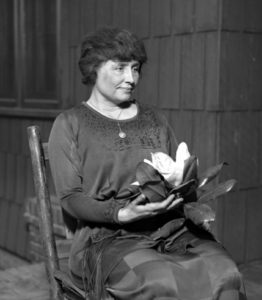
Helen Keller with Magnolia By Los Angeles Times – Los Angeles Times photographic archive, UCLA Library, Public Domain
The name Helen Keller conjures up, for many people, a deaf-blind-mute girl learning to communicate via sign language. It is a scene straight out of “The Miracle Worker,” the biographical play recounting Anne Sullivan’s role in reaching young Helen Keller. However, the amazing part of Keller’s story is not that the way she learned to fingerspell W-A-T-E-R, but what she chose to say once she could sign, read Braille, write, and speak.
Helen Keller is one of the most beloved figures in American history. Few people, however, remember her as a socialist, pacifist, and activist. Wikipedia reports, “A prolific author, Keller was well-traveled and outspoken in her convictions. A member of the Socialist Party of America and the Industrial Workers of the World, she campaigned for women’s suffrage, labor rights, socialism, and other similar causes.”
Keller was celebrated as a miracle, but her intelligent and articulate views and opinions were denounced as irrational, misguided thinking that came as the result of her afflictions. Keller railed against these charges. Responding to one attack in the Brooklyn Eagle, she wrote:
“At [one] time the compliments he paid me were so generous that I blush to remember them. But now that I have come out for socialism he reminds me and the public that I am blind and deaf and especially liable to error. I must have shrunk in intelligence during the years since I met him. … Oh, ridiculous Brooklyn Eagle! Socially blind and deaf, it defends an intolerable system, a system that is the cause of much of the physical blindness and deafness which we are trying to prevent.”
Keller was highly adept at connecting the dots between the issues, understanding the relationship of war and militarism to economic injustice and the abuse of women, workers, children, and others. She also understood the power of nonviolent struggle, noncooperation, and organized direct action.
In her famous 1916 “Strike Against War” speech, Keller said to the workers of the nation, “It is in your power to refuse to carry the artillery and the dread-noughts and to shake off some of the burdens, too, such as limousines, steam yachts, and country estates. You do not need to make a great noise about it. With the silence and dignity of creators you can end wars and the system of selfishness and exploitation that causes wars. All you need to do to bring about this stupendous revolution is to straighten up and fold your arms.”
Helen Keller Day commemorates her birth on June 27,1880. On this day, one way to honor her life and legacy is to share the story of her commitment to pacifism, ending war, equality, women’s rights, labor and workers’ rights, suffrage, and more. Remember her as a woman who understood the relationship between systems of injustice, and the challenges of being deaf, blind, or mute. Keller clearly saw that while she had lost sight and hearing through illness, many people were becoming deaf or blind through workplace injuries, poverty-related sicknesses, and lack of access to affordable healthcare. To honor and commemorate her life, find a way to work for social justice in your community, and tell her story wherever you go.
______________________
A uthor/Activist Rivera Sun, syndicated by PeaceVoice, is the author of The Dandelion Insurrection, Billionaire Buddha and Steam Drills, Treadmills, and Shooting Stars, the cohost of Love (and Revolution) Radio, and the cofounder of the Love-In-Action Network. She is a trainer and social media coordinator for Campaign Nonviolence and Pace e Bene. Sun attended the James Lawson Institute on Strategic Nonviolent Resistance in 2014 and her essays on social justice movements appear in Truthout and Popular Resistance. www.riverasun.com
uthor/Activist Rivera Sun, syndicated by PeaceVoice, is the author of The Dandelion Insurrection, Billionaire Buddha and Steam Drills, Treadmills, and Shooting Stars, the cohost of Love (and Revolution) Radio, and the cofounder of the Love-In-Action Network. She is a trainer and social media coordinator for Campaign Nonviolence and Pace e Bene. Sun attended the James Lawson Institute on Strategic Nonviolent Resistance in 2014 and her essays on social justice movements appear in Truthout and Popular Resistance. www.riverasun.com
June 22, 2016
Got Strategy? Actions – Campaigns – Movements!
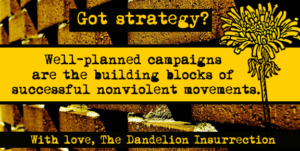 If I could make one wish come true on a silver-headed dandelion, it would be to instill a deeper understanding of strategy for nonviolent movements into every single person working for change.
If I could make one wish come true on a silver-headed dandelion, it would be to instill a deeper understanding of strategy for nonviolent movements into every single person working for change.
As my friend, Philippe Duhamel told me once, “Strategy without action is futile . . . but action without strategy is fatal.”
So, here’s a strategy tip: a movement is more than an action or two (or even a hundred actions). Sets of well-chosen nonviolent tactics combine to work toward the goals of strategic campaigns. These campaigns ideally build cumulatively on the accomplishments of the previous campaigns, like a set of stepping stones in a staircase that leads toward the broad aims of the movement.
Got that? Actions make up campaigns, which build cumulatively into the arc of a movement.
Campaigns can accomplish a lot of goals … they can strengthen a movement, build participation in the movement. They can erode the position of your opposition by undermining the “pillars of support” that keep the problem in place. They can build new systems and encourage people to leave the old system and join in. They can sway people to shift from being enemies to being allies of the movement, and help people move from passively supporting the goals of the movement to being actively involved in the nonviolent actions and organizing of the movement.
Ponder this with me. In the social change work you’re involved in, are you just engaging in actions upon actions without the framework of campaigns? Or are you pouring energy into campaigns that don’t seem to be building toward a larger goal? Perhaps stop and reassess how the movement is approaching it’s work.
We are part of a long lineage of nonviolent struggle, one that stretches around the world and throughout time. People have lived and loved and suffered and died for this knowledge. Every grain of strategic understanding we know about nonviolent struggle has been brought to us through the hard-won efforts of our fellow human beings. Honor them by researching and studying how nonviolent action works. Respect your fellow human beings and use strategy as you move into action.
I learned this knowledge while writing The Dandelion Insurrection. I realized I didn’t know how to get my characters out of the mess they were in. I googled, “how to bring down dictators nonviolently”, which led me to Gene Sharp‘s work, which lead me to Gandhi, King, the Global Nonviolent Action Database, and a stack of books on nonviolent struggle that is literally taller than I am. The knowledge I learned is the most empowering, important knowledge I have ever engaged with. I recommend the journey, my friends.
What is The Dandelion Insurrection? It’s a novel about a nonviolent movement for change in “a time that looms around the corner of today”, set in a (slightly) fictionalized United States to oust a not-so-hidden corporate dictatorship. Whether or not it’s real . . . well, that all depends on you. Read the book, live the story.
_____________________
A uthor/Activist Rivera Sun, syndicated by PeaceVoice, is the author of The Dandelion Insurrection, Billionaire Buddha and Steam Drills, Treadmills, and Shooting Stars, the cohost of Love (and Revolution) Radio, and the cofounder of the Love-In-Action Network. She is a trainer and social media coordinator for Campaign Nonviolence and Pace e Bene. Sun attended the James Lawson Institute on Strategic Nonviolent Resistance in 2014 and her essays on social justice movements appear in Truthout and Popular Resistance. www.riverasun.com
uthor/Activist Rivera Sun, syndicated by PeaceVoice, is the author of The Dandelion Insurrection, Billionaire Buddha and Steam Drills, Treadmills, and Shooting Stars, the cohost of Love (and Revolution) Radio, and the cofounder of the Love-In-Action Network. She is a trainer and social media coordinator for Campaign Nonviolence and Pace e Bene. Sun attended the James Lawson Institute on Strategic Nonviolent Resistance in 2014 and her essays on social justice movements appear in Truthout and Popular Resistance. www.riverasun.com
June 20, 2016
Women’s Draft? Sign Me Up To Abolish War
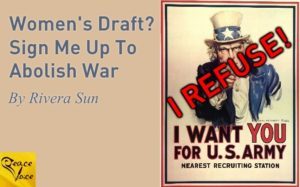 For too long, the women of this nation have been complacent while our brothers, sons, husbands, and fathers are sent to kill, maim, brutalize, destroy and even die in defense of our alleged liberty.
For too long, the women of this nation have been complacent while our brothers, sons, husbands, and fathers are sent to kill, maim, brutalize, destroy and even die in defense of our alleged liberty.
But now, the Senate has passed a $602 billion defense bill that includes an amendment for drafting women. If this bill were in effect today, I would be fined a quarter of a million dollars and face five years in prison for writing these words:
Women: do not register for the draft.
No one – man or woman – should register, or be required to register, for the draft. The draft should be completely eliminated. The military should be dismantled. War should be abolished. The bloated war budget should be returned to our children and students. The military industrial complex should be evicted from our politics and war profiteering should be completely and utterly outlawed.
According to the new bill, saying this and telling other women not to register for the draft is against the law, but I’ll say these words as long as I live in every way I can . . . and I’ll tell it to men, too. For too long, this nation has sat idle as horrific wars are waged in our names. Now, a Congress of the same predominantly rich, white, old men who send our brothers off to war would like the women of this country to pick up the weapons in our very own hands.
I refuse.
More than refuse, I will organize, not just to stop the Women’s Draft, but to abolish war in its entirety. Did Congress think that “women’s equality” meant sending us off to war? Women’s equality is peace, democracy, economic justice, racial justice, environmental sustainability, restorative justice, ending mass incarceration, providing for all children of this country, caring for our elders, affordable healthcare and housing, and debt-free student education.
Women’s equality does not – and never will – include forcing us to kill our fellow human beings in order to protect the patriarchal, oligarchic, racist, imperialistic interests of the greedy, war-profiteering few.
There is something ludicrous about the very notion of drafting me into the military. I imagine what Helen Keller (a notorious anti-war activist) might have told me: sit-down, strike, and refuse to die in the rich men’s wars. Kathy Kelly and Medea Benjamin might smile on my first day of boot camp as I engage in total noncooperation with the training and speak to my fellow women about the injustice and horror of war. What will the officers do then? Throw me in prison, where, like peace activists and all organizers, I might organize work strikes and refuse to build the infrastructure of war? Would they put me in solitary confinement like Chelsea Manning for speaking truth to power? Would they torture me as they do to the illegally and unfairly held men at Guantanamo? Would they rape me like they already do to one third of my sisters in the military?
Undoubtedly, our congresspersons were not thinking of me when they introduced the women’s draft bill. Perhaps they were thinking of my blonde cousins – some of who are military wives – marching teary-eyed as they go off to kill children that do not look so different than the ones they leave behind. Perhaps they imagined black and brown bodies dying to protect a racist nation that incarcerates, murders, and impoverishes them. Perhaps they imagined my veteran friends, and thought that women, too, should join the ranks of those haunted by the horrors of war, suffering from PTSD. Perhaps they thought of us smiling and waving as we’re trotted out for Memorial Day parades and shows of patriotism.
Certainly, they did not have Rivera Sun in mind, a five-foot-five, redheaded, nonviolent strategist with a pen sharper than a hellfire missile. If so, they would have quietly killed the women’s draft bill . . . because there is only one place the US military is drafting Rivera Sun – and that’s straight into the peace movement.
Women: do not register for the draft. Let us do what we should have done long ago. For too long, we have been complacent as our sons, brothers, husbands, and fathers were sent off to war. No more. The sleeping giant of American womenkind has awakened . . . and she wants the total Abolition of War.
Celebrating Grace Lee Boggs
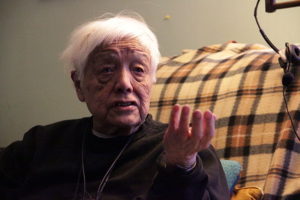
Grace Lee Boggs By Kyle McDonald – Flickr: IMG_8554, CC BY 2.0
On June 27, 1915, Grace Lee Boggs was born in Providence, Rhode Island, above her father’s restaurant. Grace later said, “because I was born to Chinese immigrant parents and because I was born female, I learned very quickly that the world needed changing.”
Over her 100 years of life, Grace would, indeed, change the world . . . and herself. She began her organizing work with labor and workers’ rights, tenant’s rights, and the struggles of the African-American community. In 1953, she married African-American autoworker and political activist James Boggs and moved to Detroit where they focused on the Civil Rights and Black Power movements.
Her approach to activism and social change shifted dramatically over her long, engaged lifetime. Her ideology began with Marxist, violent revolutions as the primary mechanism of change, but then she expanded her thinking and began to understand that change happens on the social and cultural levels, not just the political and economic. During the Civil Rights and Black Power movements, she started out unconvinced of Dr. King’s nonviolence. The Detroit Riots of 1967 and the rise of violent crime in her community, made her question violence as a means to change.
In a 2012 interview, she said, “I was not a supporter of Martin Luther King during the early period because I was in Detroit talking about Black Power and Malcolm. But when violence began to break out amongst us, I think we had to begin rethinking- why is non-violence such an important, not just a tactic, not just a strategy, but an important philosophy? Because it respects the capacity of human beings to grow- it gives them the opportunity to grow their souls and we owe that to each other. I used to think of it in very political purely narrow superficial terms but you know you grow older you grow wiser.”
Boggs eventually adopted Dr. King’s nonviolent strategies and fostered Dr. King’s vision of “beloved communities,” in Detroit. She started food cooperatives and community groups to support the elderly, fought utility shut-offs, and organized unemployed workers. She combated crime by organizing protests outside known crack houses and promoted civic reforms. In 1992, she founded Detroit Summer, an intergenerational, multicultural youth program.
A documentary film, “American Revolutionary: the Evolution of Grace Lee Boggs,” shows the powerful transformations throughout her life, both personal and political. Her story is an important one for all Americans to know, for it chronicles the life of a woman who unceasingly questioned and examined her beliefs, and worked for justice and change.
______________________
A uthor/Activist Rivera Sun, syndicated by PeaceVoice, is the author of The Dandelion Insurrection, Billionaire Buddha and Steam Drills, Treadmills, and Shooting Stars, the cohost of Love (and Revolution) Radio, and the cofounder of the Love-In-Action Network. She is a trainer and social media coordinator for Campaign Nonviolence and Pace e Bene. Sun attended the James Lawson Institute on Strategic Nonviolent Resistance in 2014 and her essays on social justice movements appear in Truthout and Popular Resistance. www.riverasun.com
uthor/Activist Rivera Sun, syndicated by PeaceVoice, is the author of The Dandelion Insurrection, Billionaire Buddha and Steam Drills, Treadmills, and Shooting Stars, the cohost of Love (and Revolution) Radio, and the cofounder of the Love-In-Action Network. She is a trainer and social media coordinator for Campaign Nonviolence and Pace e Bene. Sun attended the James Lawson Institute on Strategic Nonviolent Resistance in 2014 and her essays on social justice movements appear in Truthout and Popular Resistance. www.riverasun.com
June 14, 2016
Dorothy Day Refuses To Duck-And-Cover

Duck-and-Cover Drill
On June 15th, 1955, Catholic Worker founder Dorothy Day joined a group of pacifists in refusing to participate in the civilian defense drills scheduled on that day. These drills were to prepare the citizenry in the event of a nuclear attack, and involved evacuations of city centers, taking shelter in subway tunnels, and, for schoolchildren, “duck-and-cover” to hide under their school desks. Such actions would be futile if a nuclear attack were underway, but the drills were part of a government propaganda program to convince Americans that nuclear weapons were a necessary part of the US arsenal, and that it would be possible to survive a nuclear war.
In this particular case, Operation Alert was a nationwide, mandated, legally enforced drill.Dorothy Day, fellow Catholic Workers and other pacifists informed the media that they would disobey the law, and refused to evacuate public spaces and work places for the proscribed fifteen-minute period. Instead, they sat on park benches in City Hall Park, quietly praying and meditating. All 27 – and a shoeshine man who was taken into custody by mistake – were arrested. They were branded murderers by their judge, who accused them of being responsible for the simulated deaths of three million New Yorkers.
Day said she was doing “public penance” for the United States’ first use of atom bombs in Hiroshima and Nagasaki. She and other protesters plead guilty to the charges, but the judge ultimately refused to send them to jail, saying, “I’m not making any martyrs.” For the next five years, Dorothy Day and many others engaged in similar acts of civil disobedience, refusing to cooperate with the civilian defense drills.
In 1960, more than 600 New Yorkers joined them at City Hall Park, with simultaneous demonstrations at CCNY, Brooklyn College, Queens College, Columbia University and several New York City high schools in noncooperation with the drills. When young mothers with children joined the protests in 1960, opposition to the drills increased, and the drills were stopped after the 1961 protest. Historians point to these campaigns and many others of the time as drivers toward the 1963 Partial Test Ban Treaty negotiated, signed by President Kennedy, and ratified by the US Senate.
This campaign is an excellent example of the power of nonviolent action, combining noncooperation with drills, civil disobedience of unjust laws, public acts of protest and persuasion, among others. The pacifists also used letters, speeches, trials, public statements, and interviews to convey the immorality of nuclear weapons and to expose the hidden agenda of the US government. The careful strategizing of noncooperation and protests brought a halt to the civilian defense drills, demonstrating to the US government that the populace would not passively comply with the unspeakable horrors of nuclear weapons.
As we know, the work is far from complete. With one trillion dollars slated for expanding the nuclear arsenal over the next 30 years, it may be time to dust off this chapter of nonviolent history, and tackle modern nuclear challenges with organizing nonviolent action.
______________________
A uthor/Activist Rivera Sun, syndicated by PeaceVoice, is the author of The Dandelion Insurrection, Billionaire Buddha and Steam Drills, Treadmills, and Shooting Stars, the cohost of Love (and Revolution) Radio, and the cofounder of the Love-In-Action Network. She is a trainer and social media coordinator for Campaign Nonviolence and Pace e Bene. Sun attended the James Lawson Institute on Strategic Nonviolent Resistance in 2014 and her essays on social justice movements appear in Truthout and Popular Resistance. www.riverasun.com
uthor/Activist Rivera Sun, syndicated by PeaceVoice, is the author of The Dandelion Insurrection, Billionaire Buddha and Steam Drills, Treadmills, and Shooting Stars, the cohost of Love (and Revolution) Radio, and the cofounder of the Love-In-Action Network. She is a trainer and social media coordinator for Campaign Nonviolence and Pace e Bene. Sun attended the James Lawson Institute on Strategic Nonviolent Resistance in 2014 and her essays on social justice movements appear in Truthout and Popular Resistance. www.riverasun.com
June 1, 2016
On June 2nd Remember the Mother’s Day Peace Proclamation

Photo Credit: Julia Ward Howe By John Elliott (1858 – 1925), Public Domain
Every year in May, peace activists circulate Julia Ward Howe’s Mother’s Day Peace Proclamation. But, Howe did not commemorate Mother’s Day in May . . . for thirty years Americans celebrated Mother’s Day for Peace on June 2nd. It was Julia Ward Howe’s contemporary, Anna Jarvis, who established the May celebration of mothers, and even then, Mother’s Day was not a brunch and flowers affair. Both Howe and Ward commemorated the day with marches, demonstrations, rallies, and events honoring the role of women in public activism and organizing for social justice.
Anna Jarvis’ vision of Mother’s Day began when she organized Mothers’ Work Days in West Virginia in 1858, improving sanitation in Appalachian communities. During the Civil War, Jarvis convinced women from both sides of the conflict to nurse the wounded of both armies. After the end of the war, she convened meetings to try to convince the men to lay aside grievances and lingering hostilities.
Julia Ward Howe shared Anna Jarvis’ passion for peace. Written in 1870, Howe’s “Appeal to Womanhood” was a pacifist reaction to the carnage of the American Civil War and the Franco-Prussian War. In it, she wrote:
“Our husbands shall not come to us, reeking with carnage, for caresses and applause. Our sons shall not be taken from us to unlearn all that we have been able to teach them of charity, mercy and patience. We, women of one country, will be too tender of those of another country, to allow our sons to be trained to injure theirs. From the bosom of the devastated earth a voice goes up with our own. It says: Disarm, disarm! The sword of murder is not the balance of justice. Blood does not wipe out dishonor, nor violence vindicate possession. As men have often forsaken the plough and the anvil at the summons of war, let women now leave all that may be left of home for a great and earnest day of council.”
As time went on, Congress approved the annual commemoration of Mother’s Day in May, and businessmen quickly capitalized on sentimentality and eradicated the powerful calls-to-action both women intended in the original Mother’s Day concepts. Anna Jarvis’ daughter would campaign for years against flowers and chocolates, seeing clearly the commercialization of honoring women and mothers would lead us further from the call to take action.
Consider these stories as the wheel of the year turns around. By next May, perhaps you’ll find a way to honor your mother for her social and political activism, her engagement with resolving injustice, her care for the sick, elderly, or infirm, or perhaps even her staunch opposition to the carnage of war.
Read the whole Mother’s Day Peace Proclamation here.
______________________
A uthor/Activist Rivera Sun, syndicated by PeaceVoice, is the author of The Dandelion Insurrection, Billionaire Buddha and Steam Drills, Treadmills, and Shooting Stars, the cohost of Love (and Revolution) Radio, and the cofounder of the Love-In-Action Network. She is a trainer and social media coordinator for Campaign Nonviolence and Pace e Bene. Sun attended the James Lawson Institute on Strategic Nonviolent Resistance in 2014 and her essays on social justice movements appear in Truthout and Popular Resistance. www.riverasun.com
uthor/Activist Rivera Sun, syndicated by PeaceVoice, is the author of The Dandelion Insurrection, Billionaire Buddha and Steam Drills, Treadmills, and Shooting Stars, the cohost of Love (and Revolution) Radio, and the cofounder of the Love-In-Action Network. She is a trainer and social media coordinator for Campaign Nonviolence and Pace e Bene. Sun attended the James Lawson Institute on Strategic Nonviolent Resistance in 2014 and her essays on social justice movements appear in Truthout and Popular Resistance. www.riverasun.com
May 27, 2016
Ordinary Insurrections
 Consider this post an act of rebellion . . . a nonviolent action against the tide of business as usual. It’s just another Sunday at my house, but after over a decade of thinking, reflecting, learning, and changing, Sunday afternoons involve dozens of constructive actions that remove my consent from destructive systems and place my cooperation into life-affirming practices.
Consider this post an act of rebellion . . . a nonviolent action against the tide of business as usual. It’s just another Sunday at my house, but after over a decade of thinking, reflecting, learning, and changing, Sunday afternoons involve dozens of constructive actions that remove my consent from destructive systems and place my cooperation into life-affirming practices.
For instance: we cleaned the house. No toxic chemical soaps or detergents. We did a load of laundry; the water goes out to the gray water ditch in the yard. I took a bath last night and put the water on the garden beds. I weeded last year’s pokey gray stalks out of the yard and put them on the compost pile.
My Sunday entertainment was – not violent action flicks, nope – editing our weekly radio show, listening to words of love and revolution over and over. I’m re-reading a book byDavid Bollier that I highly recommend, “Think Like A Commoner”, and a used bookstore find, “A Simpler Way” by Margaret Wheatley and Myron Kellnor-Rogers. I might write a snail mail letter to my brothers and sisters. When I mail it, I’ll stick a jar of homemade aloe vera gel into the box, because it’s getting to be sunshine and outdoor season, and all of us redheads burn!
 I turned the mullein and hoarhound leaves over as they’re drying. They make great winter cold remedies, so I always try to gather them from the yard at this time of year. My landlady, Jenny, told me about this. I’m also bundling fresh sage smudges, because I give them as gifts to people when I travel to teach workshops. I checked on my newest science experiment . . . my kombucha creature that lives in a jar on top of the fridge (so far, so good).
I turned the mullein and hoarhound leaves over as they’re drying. They make great winter cold remedies, so I always try to gather them from the yard at this time of year. My landlady, Jenny, told me about this. I’m also bundling fresh sage smudges, because I give them as gifts to people when I travel to teach workshops. I checked on my newest science experiment . . . my kombucha creature that lives in a jar on top of the fridge (so far, so good).
I’m boycotting America-As-Usual. No flag-waving. No hate-mongering. No shopping for things made in sweatshops overseas or harvested by underpaid and abused migrant workers. I’m learning and studying without getting indebted to the educational-industrial complex. I’m gathering herbs in resistance to Big Pharma.
And no, I’m not perfect. There’s more work to be done. Room for growth, change, culture-shifting. But today, as I think about it, my life is an act of resistance and resilience. And it’s great! Beautiful, grounded, fun, luxurious in a simple way.
Share your stories, tell your tales, let others know about how you’re living in these changing times.
____________________________
A uthor/Activist Rivera Sun, syndicated by PeaceVoice, is the author of The Dandelion Insurrection, Billionaire Buddha and Steam Drills, Treadmills, and Shooting Stars, the cohost of Love (and Revolution) Radio, and the cofounder of the Love-In-Action Network. She is a trainer and social media coordinator for Campaign Nonviolence and Pace e Bene. Sun attended the James Lawson Institute on Strategic Nonviolent Resistance in 2014 and her essays on social justice movements appear in Truthout and Popular Resistance. www.riverasun.com
uthor/Activist Rivera Sun, syndicated by PeaceVoice, is the author of The Dandelion Insurrection, Billionaire Buddha and Steam Drills, Treadmills, and Shooting Stars, the cohost of Love (and Revolution) Radio, and the cofounder of the Love-In-Action Network. She is a trainer and social media coordinator for Campaign Nonviolence and Pace e Bene. Sun attended the James Lawson Institute on Strategic Nonviolent Resistance in 2014 and her essays on social justice movements appear in Truthout and Popular Resistance. www.riverasun.com
From the Desk of Rivera Sun
- Rivera Sun's profile
- 161 followers



